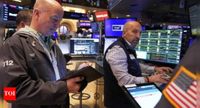Wall Street opened the week on a cautious note, as major indices retreated amid a combination of falling oil prices, renewed trade tensions, and profit-taking that weighed on investor sentiment. On May 5, 2025, the Dow Jones Industrial Average dropped by more than 100 points, while the S&P 500 edged closer to ending its longest winning streak in two decades.
In early trading, the Dow was down over 170 points, or 0.41%, with the S&P 500 losing 0.7% and the Nasdaq falling 0.8%. This pullback follows a remarkable run, where the S&P 500 surged for nine consecutive sessions—its best streak since 2004. However, the index remains 3.3% lower year-to-date and about 7.4% below its all-time high from February 2025.
A key driver of the market’s decline was the drop in oil prices. US crude fell by 1.53% after OPEC+ announced plans to boost output by 411,000 barrels per day starting in June, raising concerns about oversupply in a climate of uncertain demand. This decline in oil prices weighed heavily on energy stocks and contributed to the broader market weakness.
Meanwhile, gold prices surged by more than 2.5% as investors sought safe-haven assets amid heightened volatility and geopolitical uncertainty. The US dollar also weakened against major currencies, adding further complexity to the global markets.
Adding to the market's pressures, President Donald Trump's surprise announcement of a 100% tariff on films produced outside the United States rattled investors, particularly in the media and entertainment sectors. Shares of Netflix, Disney, and Warner Bros. Discovery all fell sharply, reflecting concerns about higher costs and potential disruptions to global content production.
Market participants are now turning their attention to the upcoming Federal Reserve meeting, where investors are eager for signals on interest rates and the central bank’s response to the evolving economic landscape. The combination of commodity price swings, trade policy uncertainty, and anticipation of monetary policy changes has injected fresh volatility into US equities.
As the S&P 500 hovers near the end of its nine-day winning streak, analysts caution that further gains may be harder to achieve in the near term. Seasonal trends and technical resistance levels could present additional headwinds, and the market’s risk/reward profile is seen as less favorable after the recent rally.
In summary, Wall Street’s pullback reflects a confluence of factors: falling oil prices, renewed tariff concerns, and a natural pause after an extended rally. Investors brace for more volatility as key economic and policy decisions loom in the days ahead.
US stock futures pointed toward losses as Wall Street opened on the same day. The S&P 500 slipped 0.3%, ending its nine-day winning streak, while the Nasdaq composite shed 0.5%. The Dow Jones Industrial Average managed a 110-point gain, or 0.3%, by midday, despite the overall negative sentiment.
Market breadth within the S&P 500 leaned positive, but the index was dragged lower by weakness in heavyweight technology stocks. Notably, Apple dropped 3%, Nvidia declined 0.7%, and Tesla fell 3.8%. Berkshire Hathaway tumbled 3.9% following Warren Buffett’s weekend announcement that he would step down as CEO by year-end after more than 60 years at the helm. Buffett will remain chairman of the board, providing some continuity at the $860 billion conglomerate.
The oil markets took a hit after OPEC+ confirmed its plan to boost production by 411,000 barrels per day starting June 1. US benchmark crude fell 2.2% to $57.05 a barrel, extending a sharp decline this year amid concerns over slowing global demand. Many producers are now operating below profitability thresholds, which adds pressure in the energy sector, with Exxon Mobil dropping 2.2%.
The broader market continues to digest the evolving effects of President Trump’s escalating trade war. Although some of the most severe tariffs expected in April were delayed, measures targeting China have moved ahead, keeping uncertainty elevated. “Uncertainty remains elevated and economic data will likely weaken in the coming months, meaning further bouts of volatility are likely,” said Ulrike Hoffmann-Burchardi, Chief Investment Officer for global equities at UBS Global Wealth Management.
This uncertainty casts a shadow over the Federal Reserve’s upcoming policy decision. The Fed is expected to hold interest rates steady Wednesday after three cuts in 2024. Inflation remains above the central bank’s 2% target, and the potential impact of ongoing trade tensions is a growing concern.
Interestingly, the US economy shrank 0.3% in the first quarter of 2025, marking the first contraction in three years. Despite that, consumer spending continues, and activity in the services sector remained in expansion territory in April, according to ISM data. Still, consumer confidence has wavered amid policy shifts and tariff threats.
Adding to the volatility, President Trump announced via Truth Social on Sunday that the US will impose a 100% tariff on films produced outside the country. Given that most films have multinational production, the implications remain unclear. Shares of Netflix fell 1.8% and Warner Bros. Discovery slid 1.1% on May 5, 2025.
In some positive news, Skechers soared 24.6% after reports it would be taken private in a $9 billion deal by 3G Capital. Other shoemakers rose in tandem, with Crocs gaining 4.2% and Deckers Outdoor up 1.7%. Meanwhile, US Treasury yields inched higher, with the 10-year yield rising to 4.35% from 4.31% late Friday, May 2, 2025.
As the market grapples with these multifaceted challenges, analysts and investors alike remain watchful of the unfolding economic landscape and the potential for further volatility ahead.




